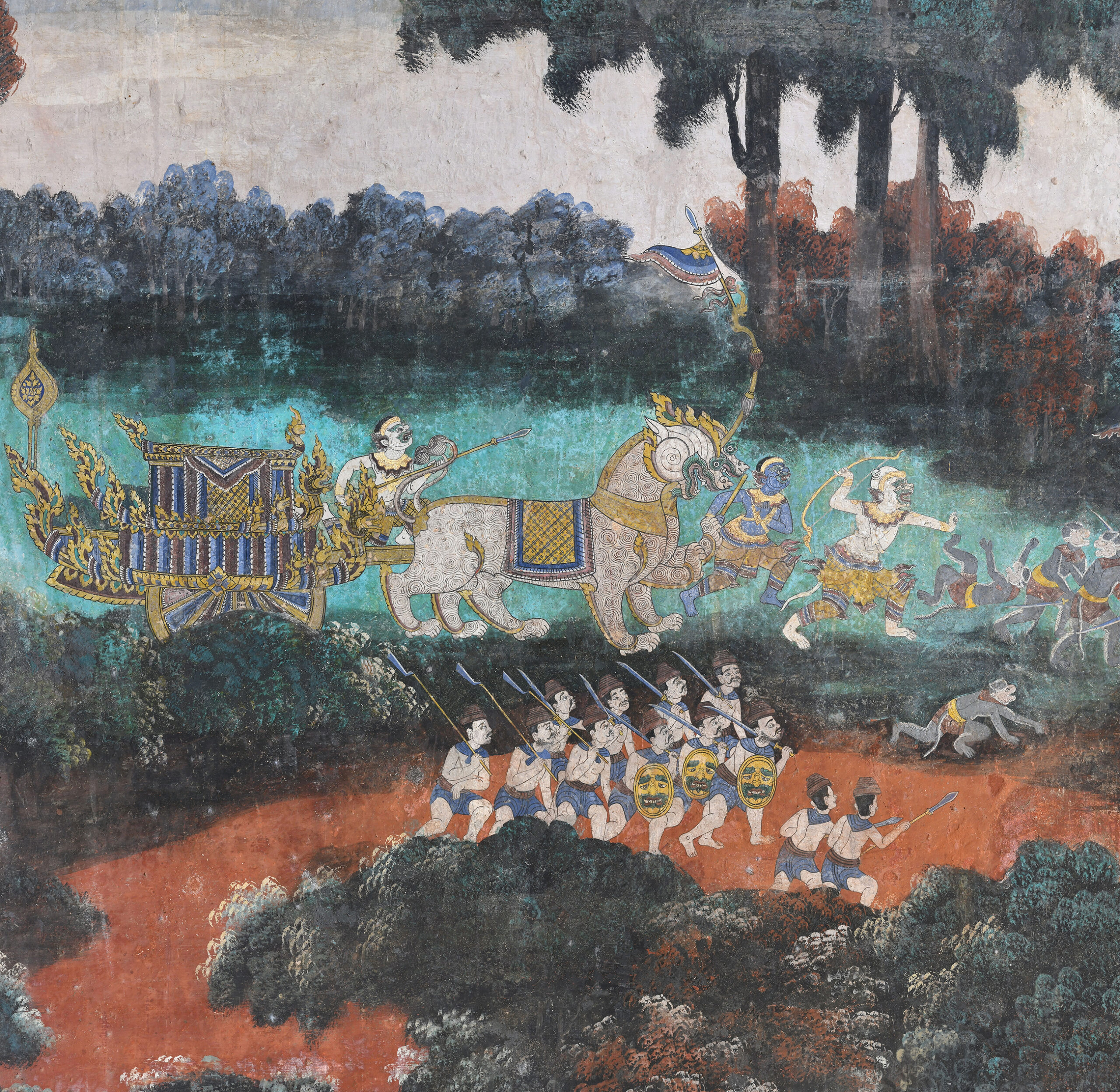The Silver Pagoda is an impressively ornate structure, also known as Wat Preah Keo, or ‘Temple of the Emerald Buddha’, located inside the Royal Palace of Phnom Penh. Originally built as a wooden construction in 1892 under King Norodom, it was rebuilt in its current state in 1962. It stands inside a large, enclosed complex, surrounded by a painted gallery on all four sides with a dominant canopy at the top and a sloping roof, forming a cloister.
The murals in the galleries of the Silver Pagoda date from 1902-1903. They were executed by the painter and architect Oknha Tep Nimit Thak, assisted by painter Vichitre Chea and a team of 40 students, thus making it very difficult to correctly attribute the different parts of these works.
Oknha Tep Nimit Mak was the painter and master builder of the Palace at the end of the 19th century and the beginning of the 20th century. We owe to this master and his workshop the paintings of the great monasteries of this period: the sanctuary and cloister of Wat Prah Keo Morokot, Wat Phnom Delmayed, Wat Phnom Del in Kompong Cham province and Vat Sisowath Ratanaram in the South of Kandal Province.
The courtyard, surrounded by galleries, has the shape of a rectangle of 150 m by 170 m, the murals occupy the entire surface of the walls, they are 3.50 meters high and 604 meters long, making them the largest wall paintings in Southeast Asia. Starting on the Eastern wall, near the entrance door, and proceeding in a clockwise direction (pradaksimâ), 192 scenes representing the Reamker, the Khmer version of the classic Indian epic Rāmāyaṇa, depict the battle between the army of Preah Ram (Rama) to rescue his wife Neang Seda kidnapped by Krong Rab (Ravana).
In this enclosure of traditional art, one can see the whole Rama story unfold, from the moment when Preah Ram accompanied by Preah Laks goes to perfect his knowledge with the ascetic Visvamitr to the end when Preah Ram and Neang Seda are reconciled and receive the visit of Preah Bhirut and Sutrut. Almost all the most important episodes are represented:
- The trial of the bow at King Janak’s house
- Preah Ram and Neang Seda in Ayodhya – Departure from Ayodhya – Exile – Encounters with Kukhan and Munis.
- Mutilation of Neang Surpanakhar, Rab’s sister – Battle with Krong Khar – the golden gazelle, Seda’s abduction
- Battles with Rab’s allies – Battle of Kumbhakar-Battle of Indrajit – Battle of Rab.
- Victory of Preah Ram – Consecration of Bibhek – Seda’s fire ordinance
- Return to Ayodhya, coronation of Preah Ram
- Portait of Rab – condemnation of Seda – his exile
- Ramlaks and Jupalaks – the horse trial
- Preah Ram, Neang Seta and the two children – their meeting
- Preah Ram and the ordeal with the funeral urn. Seda among the Nagas
- Wars of Rab’s children and nephews
- Reconciliation of the heroes.
No frame, no division, not even a stripe, separates the scenes. The transitions between two episodes are made in an elegant, more elaborate way, by a grove, a group of rocks or, simply, by the attitude of characters directing their attention towards specific elements of the scene. Except for a few flashbacks, the story is laid out in a chronological order, with succinct inscriptions in Khmer describing the action.
These paintings, so precious, bear witness to the enduring artistic sense of the Khmer people. They present a particularly rich iconography, preserving a very lively Khmer life with religious and royal celebrations, as well as scene of popular life, in an oneiric atmosphere of poetry.
For the first time in their history, the painted murals of the Silver Pagoda were studied extensively through several non-invasive analyses, including infrared reflectography images (IR) acquired with Opus Instruments’s Osiris camera, allowing for the study of the work’s genesis and underlying layers.
As a general rule and at that time (early 20th century), Cambodian artists expressed themselves through an essentially linear drawing: to represent and signify. On the Silver Pagoda’s surrounding walls, and as was the case in Cambodia during this period, the technique excludes any perspective representation or any use of trompe-l’oeil. The drawing is linear, the lines and the curves are clear and defined. There is also an absence of perspective: the writing is simple and is intended to be as exact and faithful as possible to the Ramkear text.
As stated earlier, Oknha Tep Nimit Mak is one of the artists who worked on the Silver Pagoda. It is also known that he produced drawings of statues, decorative motifs, mythological characters, costumes… . In 1923, George Groslier collected seventy-six drawings by Oknha Tep Nimit Mak; although the position of the figure and some details differ, the similarities between the drawings and the characters in the Silver Pagoda are obvious and seem to stem from the same idea. We can therefore assume that the artists used a model or cardboard of some kind, as underlined by the strong and precise lines.
The underlying drawings of the Silver Pagoda are very rich and bear witness to the artist’s vision and creative process at the time of painting. Reflectography has revealed adjustments to the composition made by the artist during the painted phase.
The most repainted part (eastern wall) underwent the most modifications and changes: the architecture, decorations and characters have been simplified; the lines are less delicate, some characters are repositioned or simply created new. This tells us that a new group of artists worked on this part of the wall after the completion of the project or after the damage that the original painting may have suffered.
On the whole composition we observe:
- Numerous compositional changes in the architecture;
- Removal of some characters: some characters or groups of characters disappear in the painted phase, especially on the repainted part where the modifications are the most obvious;
- Slight displacements, especially for characters and animals: adjustment of the positions of figures – feet position, arms position, architectural details, etc;
- Squaring: to place groups of characters (often duos);
- Drawing of lines for inscriptions.
Reflectography also allowed us to determine the missing drawing on the very damaged areas of the mural. Indeed, some parts have been altered by time, environment, weather changes and deliberate damage by visitors. The reflectography thus allow to better understand the scenes represented.
The artist used a mixed technique: most of the lines are made with dry materiel, they are strong and precise; but some elements, such as vegetation, stones, or rivers/sea seem to have been made with a more fluid material.
The analysis in false color, traditionally performed using color films with extended sensitivity in the near-infrared region, is now more conveniently achievable with digital techniques using a modern camera. The advantage lies in the speed of acquiring infrared analysis in false colors, and moreover, the near-infrared sensitivity of silicon detectors extends to longer wavelengths compared to color film.
An example can be found on the west wall in the scene depicting the battle between Rama and Krong Rab (scene 118), where false-color images reveal an area affected by previous restoration interventions. In particular, from false color, the presence of overlaid malachite can be identified on the original layer of ultramarine representing the sky.
What appears to us in direct light photography as a compact layer of bright blue differentiates into two overlapping layers in false color, which can be perfectly distinguishable from each other thanks to the characteristic responses of the two different pigments.
Equally useful can be the identification of pigments that have deteriorated over time. In the north wall, in the scene where Asakan gathers his troops against Rama (scene 132), the pigment has deteriorated. In false color, the area inside the temple is rendered in red, while it appears dark brown in direct light.
It is characteristic of blue pigments to have a red response in false color, and enamel is a pigment prone to such degradation. Its tendency to degrade, darkening towards gray-brown tones, is scientifically recognized.













